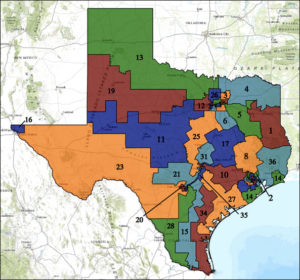By Jim Ellis

Map of US Congressional districts in Texas
The turnout theory loses its steam when actually comparing the participation numbers not only with 2020 Republican turnout and understanding that the GOP has a virtually unopposed presidential candidate for its nomination, but also when overlaying recent political history.
When studying the numbers, one sees that the 2008 Democratic primary’s participation rate between Barack Obama and Hillary Clinton far exceeded the numbers posted in this year’s primary, which was held on March 3 – Super Tuesday. In 2008, we see that 33.2 percent of the registered voters participated in one of the major party primaries. This year, the combined turnout represented 25.2 percent of the registered voter pool.
And, 12 years ago, according to figures published in this March 6 Texas Tribune article, two-thirds of those voters chose a Democratic ballot to vote in the Obama-Clinton primary versus just one-third who entered the Republican primary to support John McCain over former Arkansas governor, Mike Huckabee.
This year, 12.8 percent of the registered Texas voters chose the Democratic primary versus 12.4 percent who picked a Republican ballot even though there was no competitive GOP contest. Furthermore, the combined 25.2 percent total participation factor is actually the second-lowest turnout in the past four elections.
Most importantly, however, as a gauge toward predicting general election turnout and result, while two-thirds of the 2008 voters chose the Democratic ballot in the primary in the largest percentage turnout of the century, Republican John McCain would later post a 55-44 percent general election victory within the Texas electorate.
While Democratic statewide turnout did exceed the number of Republicans voting early or visiting the polls this year, the difference was minuscule. A total of 2,071,745 individuals voted in the Democratic primary while 2,008,385 participated on the Republican side. Since the presidential race was likely the turnout driver, the fact that a highly charged Democratic primary among several competitive contenders barely out-polled a Republican race where the incumbent president was virtually unopposed is of no tangible significance as a predictor of general election preference.
